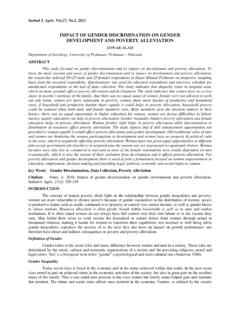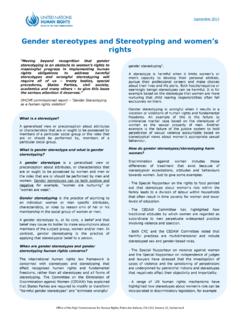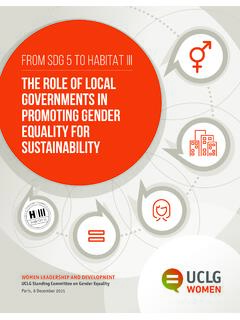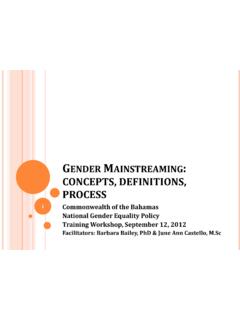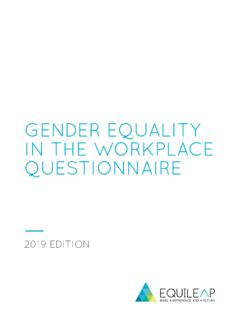Transcription of Gender and Indigenous Peoples - United Nations
1 Gender and Indigenous Peoples Briefing Note #1 PAGES. Overview 1-5. Briefing Note #2. Economic and social development 7-12. Briefing Note #3. education 13-17. Briefing Note #4. Culture 19-22. Briefing Note #5. environment 23-27. Briefing Note #6. human rights 29-33. United Nations Office of the Special Adviser on Gender Issues and Advancement of women and the Secretariat of the United Nations Permanent Forum on Indigenous Issues Indigenous women have organized at local, national and international levels to address the specific issues and challenges that they face. At the United Nations , Indigenous women have been advocates and leaders since the very first year of the Working Group on Indigenous Populations, in 1982 in Geneva, Switzerland.
2 Cover photos, left to right: (1) Broddi Sigurdarson, (2) UNICEF/NYHQ1997-1083/Pirozzi, (3) UNICEF/NYHQ1993-1860/Charton, (4) UNICEF, (5) UNICEF/NYHQ2006-2435/Markisz United Nations Office of the Special Adviser on Gender Issues and Advancement of women and the Secretariat of the United Nations Permanent Forum on Indigenous Issues Gender and Indigenous Peoples : Overview Indigenous women face significant challenges to the full enjoyment of their human rights. Indigenous women experience multiple forms of discrimination, often lack access to education, health care and ancestral lands, face disproportionately high rates of poverty and are subjected to violence, such as domestic violence and sexual abuse, including in the contexts of trafficking and armed conflict.
3 As the United Nations Permanent Forum on Indigenous Issues (UNPFII) has Briefing Note no. 1. stated, globalization presents additional challenges in many parts of the world. Indigenous women 's roles have eroded due the compounding factors of loss of natural resources and depletion of the ecosystems, their transformation into cash economies, changes in local, social and decision-making structures, and their lack of political status within States1. In spite of the specific challenges facing Indigenous women , there is often a reluctance to address the Gender dimensions of Indigenous Peoples ' issues, as to do so is seen as interfering with culture or imposing western values.
4 However, from socioeconomic and poverty reduction perspectives, Gender analysis is a means by which to identify and address Gender -differentiated needs in a more accurate and targeted way2. Indigenous women have organized at local, national and international levels to address the specific issues and challenges that they face. At the United Nations , Indigenous women have been advocates and leaders since the very first year of the Working Group on Indigenous Populations, in 1982 in Geneva, Switzerland. Indigenous women were active participants and contributors during the more than two decades of negotiations regarding the UN Declaration on the Rights of Indigenous Peoples , which was adopted by the General Assembly in September 2007.
5 The human rights of Indigenous women are protected by all of the provisions of the UN Declaration, which also calls for particular attention to be paid to their rights and special needs, and calls upon States to take measures to ensure that Indigenous women enjoy the full protection and guarantees against all forms of violence and As a result of their advocacy, Indigenous women also ensured that a resolution on Indigenous women was adopted at the 49th Session of the Commission of the Status of the women (CSW) in March 2005, which is the first ever on Indigenous women by this body. It is now clear that Indigenous women are claiming Gender equality and the implementation of the Beijing Platform for Action4.
6 Why are Gender issues important to Indigenous Peoples ? Indigenous Peoples carry a fragile but essential part of our common humanity. As individuals and societies, they represent an irreplaceable diversity. Participation in development should not mean absorption into the mainstream on the contrary, our task is to ensure that the human rights and human potential of Indigenous Peoples receive the needed attention; that development policies recognize the unique contribution and capacity of Indigenous Peoples ; that policymakers understand the Millennium Development Goals and the concept of development in ways which support and engage with Indigenous culture, and that we become partners in a common enterprise.
7 5. In different societies and cultures, different values and norms attached to men and women assign them different statuses. Norms and values generally attached to men and women of colonial and dominant cultures, such as purity and pollution, liability and asset, dependent and breadwinner, have segregated women and men. 1. In Indigenous communities, men and women have different Gender roles and responsibilities and for that reason they also often have different needs, desires and interests. Traditionally, Indigenous women were generally respected by Indigenous men and had equal access to and control over collective land and natural resources.
8 However, with the gradual loss of collective ownership of lands and other natural resources and the introduction by dominant outsiders of institutions of private property, Indigenous women progressively lost their traditional rights to lands and natural resources. The following has been a familiar pattern in many Indigenous communities: As the Indigenous economy, guided by the values of generalized reciprocity6, symbolic complementarity7. and customary laws that cherish Gender equity and equality, weakened, male members of some Indigenous communities became sole inheritors of lands and other property. As a result, female members have been deprived of their rights of traditional access to lands and other resources.
9 There are exceptions provided by some Indigenous matriarchal and other societies. For example, in some Indigenous communities of South and South-East Asia, including Indigenous nationalities of Nepal and certain tribes of India, Thailand and Cambodia, women enjoy a high social position and their status is not low in comparison to their male counterparts. Property is owned by both men and women in the communities of matriarchal Tharus of India, and women spend their income freely without any advice from their men relatives. In several matrilineal tribes such as Khasi, Garo and Jaintia of North-Eastern hills of India, women are entitled to hold exclusive land rights and inherit ancestral properties.
10 However, their elevated status within the family is not reflected in the bigger politico-rural canvas of the society. Certain influences of colonial and dominant cultures and traditions on Indigenous Peoples have placed Indigenous women in a difficult situation in terms of playing effective roles as custodians of their cultures. The human development index of many countries shows that the socio-economic gap between Indigenous Peoples and non- Indigenous Peoples is increasing8. A similar trend is seen in human development and empowerment between Indigenous women and men. The gap between Indigenous women and dominant group women is even wider.










